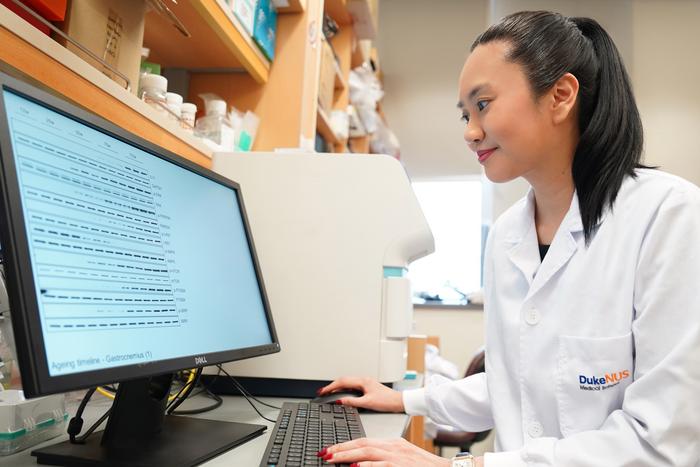An ageing population will bring colossal health, social, and economic challenges over the coming decades[1]. As people live longer, staving off the physical decline and frailty that come with age has become a holy grail, with effective interventions projected to unlock significant societal and economic benefits. Estimates suggest that a slowdown in ageing that increases life expectancy by one year alone is worth US$38 trillion.[2]

Credit: Duke-NUS Medical School, Norfaezah Binte Abdullah
An ageing population will bring colossal health, social, and economic challenges over the coming decades[1]. As people live longer, staving off the physical decline and frailty that come with age has become a holy grail, with effective interventions projected to unlock significant societal and economic benefits. Estimates suggest that a slowdown in ageing that increases life expectancy by one year alone is worth US$38 trillion.[2]
In a discovery published in Nature, a team of scientists from Duke-NUS Medical School in Singapore may have found a key to slow ageing.
The team demonstrated in preclinical models that the protein interleukin-11 (IL11) actively promotes ageing and that giving an anti-IL11 therapy not only counteracts the deleterious effects of ageing but also increases lifespan. Their discovery has the potential to play a significant role in countries’ efforts to help their population live more years in good health.
IL11 leads to fat accumulation and muscle mass loss, two key hallmarks of ageing
In preclinical studies, the team found that with age, organs expressed increasing levels of the IL11 protein, which, in turn, promoted fat accumulation in the liver and abdomen, and reduced muscle mass and strength—two conditions that are hallmarks of human ageing.
According to the team, these results are the first in the world to demonstrate that IL11 is a principal factor in ageing.
First and co-corresponding author Assistant Professor Anissa Widjaja from Duke-NUS’ Cardiovascular and Metabolic Disorders Programme, said:
“This project started back in 2017 when a collaborator of ours sent us some tissue samples for another project. Out of curiosity, I ran some experiments to check for IL11 levels. From the readings, we could clearly see that the levels of IL11 increased with age and that’s when we got really excited!”
Anti-IL11 therapy counteracts effects of ageing
After establishing IL11’s role in ageing, the team demonstrated that by applying anti-IL11 therapy in the same preclinical model, metabolism was improved, shifting from generating white fat to beneficial brown fat. Brown fat breaks down blood sugar and fat molecules to help maintain body temperature and burn calories.
The researchers also observed improved muscle function and overall better health in their study, as well as an increased lifespan by up to 25 per cent in both sexes.
Unlike other drugs known to inhibit specific pathways involved in ageing, such as metformin and rapamycin, anti-IL11 therapy blocks multiple major signalling mechanisms that become dysfunctional with age, offering protection against multimorbidity from cardiometabolic diseases, age-related loss of muscle mass and strength as well as frailty.
In addition to these externally observable changes, anti-IL11 therapy also reduced the rate of telomere shortening and preserved mitochondria’s health and ability to generate energy.
Senior author Tanoto Foundation Professor of Cardiovascular Medicine at the SingHealth Duke-NUS Academic Medical Centre Stuart Cook, who is also with Duke-NUS’ Cardiovascular and Metabolic Disorders Programme, said:
“Our aim is that one day, anti-IL11 therapy will be used as widely as possible, so that people the world over can lead healthier lives for longer. However, this is not easy, as approval pathways for drugs to treat ageing are not well-defined, and raising funds to do clinical trials in this area is very challenging.”
Prof Cook is also Senior Consultant with the Department of Cardiology at the National Heart Centre Singapore.
Assessing the potential of the research, Professor Thomas Coffman, Dean of Duke-NUS, commented:
“Despite average life expectancy increasing markedly over recent decades, there’s a notable disparity between years lived and years of healthy living, free of disease. For rapidly ageing societies like Singapore’s, this discovery could be transformative, enabling older adults to prolong healthy ageing, reducing frailty and risk of falls while improving cardiometabolic health.
“This latest research is a perfect example of contributions of Duke-NUS to Singapore’s biomedical ecosystem. Across the SingHealth Duke-NUS Academic Medical Centre, our researchers and clinician-scientists conduct truly translational research, bringing discoveries from bench to bedside, benefitting people in Singapore and around the world.”
The team’s previous research on IL11’s role in the heart and kidney (published in Nature in 2017), liver (published in Gastroenterology in 2019) and lung (published in Science Translational Medicine in 2019) led to the development of an experimental anti-IL11 therapy.
In this latest work, the Duke-NUS team collaborated with scientists from the National Heart Centre Singapore; the MRC Laboratory of Medical Sciences in the UK; the Max Delbruck Centre for Molecular Medicine in Germany; and the University of Melbourne in Australia.
Duke-NUS is a leader in academic biomedical research with a mission to advance understanding of health and disease, and collaborates with clinical and industry partners to bring translational research discoveries from bench to bedside.
This research is supported by the Singapore Ministry of Health’s National Medical Research Council under its MOH-STaR21nov-0003 and NMRC MOH-OFIRG21nov-0006, with additional support from several other grants and philanthropic gifts.
Journal
Nature
Method of Research
Experimental study
Subject of Research
Animals
Article Title
Inhibition of IL11 signalling extends mammalian healthspan and lifespan
Article Publication Date
17-Jul-2024



